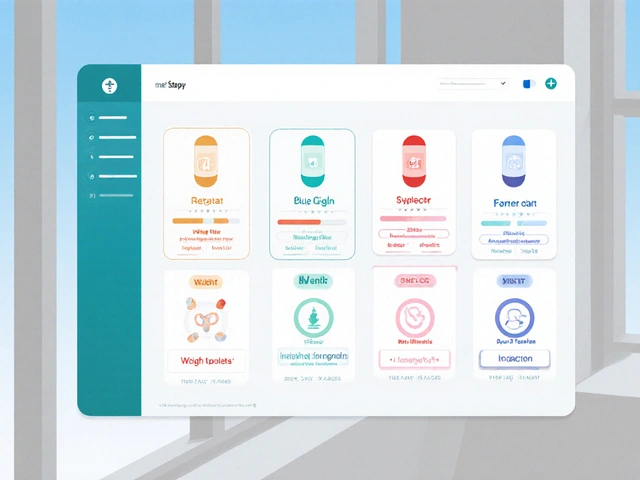Antipsychotic Comparison Tool
Key Insights
- Olanzapine: Highest efficacy but significant metabolic risks
- Aripiprazole & Lurasidone: Lower metabolic impact with good efficacy
- Clozapine: Most effective for treatment-resistant cases but requires monitoring
- Risperidone: Cost-effective with moderate side effects
Key Takeaways
- Olanzapine is highly effective for acute psychosis but carries a strong risk of weight gain and metabolic issues.
- Aripiprazole and Lurasidone offer lower metabolic side‑effects while still providing solid symptom control.
- Risperidone is a cost‑effective option for many patients, though it can raise prolactin levels.
- Clozapine remains the gold standard for treatment‑resistant schizophrenia but requires regular blood monitoring.
- Choosing the right drug hinges on efficacy, side‑effect profile, dosing convenience, and personal health factors.
What Is Olanzapine?
Olanzapine is an atypical antipsychotic medication that blocks dopamine D2 and serotonin 5‑HT2A receptors, helping to reduce hallucinations, delusions, and mood swings in schizophrenia and bipolar disorder. First approved by the FDA in 1996, it quickly became a go‑to drug for severe episodes because it controls symptoms faster than many older agents. The trade‑off is a pronounced tendency to cause weight gain, high blood sugar, and cholesterol spikes.
How Olanzapine Works
The drug’s dual dopamine‑serotonin blockade rebalances neurotransmission in brain pathways linked to psychosis. By dampening excessive dopamine signaling, it calms positive symptoms (like hearing voices). The serotonin component eases negative symptoms (such as flat affect) and mood instability. However, the same receptor actions also affect appetite regulation and insulin sensitivity, which explains the metabolic side‑effects.
Why Compare Alternatives?
Everyone’s health picture is different. A medication that works wonders for one person may cause intolerable side‑effects for another. That’s why it’s useful to line up the most common alternatives and see how they stack up on the factors that matter most: efficacy, weight impact, sedation, dosing frequency, cost, and monitoring requirements.
Top Alternatives to Olanzapine
Below are the seven most frequently prescribed antipsychotics that clinicians consider when Olanzapine isn’t the best fit.
- Risperidone - a mid‑potency atypical with strong dopamine blockade and moderate metabolic risk.
- Quetiapine - known for its calming sedative effect and relatively low prolactin elevation.
- Aripiprazole - a dopamine partial agonist that offers a lighter metabolic footprint.
- Clozapine - the most effective for treatment‑resistant cases but needs weekly blood draws.
- Ziprasidone - a low‑weight‑gain option that must be taken with food for proper absorption.
- Lurasidone - a newer atypical praised for minimal metabolic impact and once‑daily dosing.
- Haloperidol - a typical antipsychotic still used in acute settings, with higher risk of movement disorders.

Decision Criteria: What to Weigh When Picking a Drug
- Efficacy for core symptoms - Does the drug reduce hallucinations and delusions quickly?
- Metabolic side‑effects - Risk of weight gain, diabetes, and lipid changes.
- Prolactin elevation - Can cause galactorrhea, sexual dysfunction, especially with Risperidone.
- Sedation level - Helpful for agitation but may interfere with daytime functioning.
- Dosing convenience - Once daily versus multiple doses, food requirements.
- Cost and insurance coverage - Approximate price in Australia and whether PBS lists it.
- Monitoring burden - Need for bloodwork (e.g., Clozapine’s agranulocytosis monitoring).
Side‑by‑Side Comparison
| Medication | Typical Efficacy Rating* (0‑10) | Weight‑Gain Risk | Metabolic Impact | Prolactin Effect | Typical Dose (mg) | Dosing Frequency | Approx. Monthly Cost (AU$) | Special Monitoring |
|---|---|---|---|---|---|---|---|---|
| Olanzapine | 9 | High | Significant ↑ glucose & lipids | Low | 5‑20 | Once daily | ~120 | None (standard labs) |
| Risperidone | 8 | Moderate | Moderate ↑ lipids | Medium (↑ prolactin) | 1‑8 | Once daily | ~80 | None |
| Quetiapine | 7 | Low‑Moderate | Low‑Moderate | Low | 150‑800 | Once daily (extended‑release) | ~70 | None |
| Aripiprazole | 8 | Low | Minimal | Low | 10‑30 | Once daily | ~100 | None |
| Clozapine | 10 | Moderate | High (requires monitoring) | Low | 12.5‑900 | Twice daily | ~150 | Weekly CBC for agranulocytosis |
| Ziprasidone | 7 | Low | Low | Low | 20‑80 | Twice daily (with meals) | ~90 | None |
| Lurasidone | 8 | Low | Low | Low | 20‑120 | Once daily (with food) | ~110 | None |
| Haloperidol | 6 | Low | Low | Low | 0.5‑20 | Once or twice daily | ~50 | Watch for EPS (tremor, rigidity) |
*Efficacy rating reflects average symptom reduction observed in clinical trials and real‑world practice.
When Olanzapine Might Still Be the Right Choice
If rapid stabilization is the top priority-say during an acute psychotic break-Olanzapine’s high efficacy can outweigh its metabolic drawbacks. It also suits patients who struggle with medication adherence because the once‑daily dosing simplifies the routine.
Scenarios Favoring Specific Alternatives
- Weight‑concerned patients: Aripiprazole, Lurasidone, or Ziprasidone keep the scale steadier.
- History of diabetes or high cholesterol: Quetiapine or low‑metabolic agents like Lurasidone are safer bets.
- Need for low sedation: Aripiprazole and Rispiridone generally leave you more alert.
- Pregnant or breastfeeding mothers: Risperidone and Quetiapine have more data supporting relative safety.
- Treatment‑resistant schizophrenia: Clozapine remains the gold standard despite blood‑test hassles.
Practical Tips for Switching
- Consult your psychiatrist before any change; abrupt stops can cause rebound psychosis.
- Many switches require a cross‑taper period-gradually reduce Olanzapine while titrating up the new drug.
- Schedule baseline labs (fasting glucose, lipids, CBC) and repeat them 4-6 weeks after the switch.
- Track weight, appetite, and mood daily for the first month to spot early side‑effects.
- If you experience new movement symptoms, contact your doctor immediately-these can signal EPS or neuroleptic‑malignant syndrome.
Bottom Line: Tailor the Choice to the Person
No single antipsychotic fits everyone. The decision matrix above lets you compare Olanzapine against Olanzapine alternatives across the dimensions that matter most to you or your loved one. Talk openly with your healthcare team about efficacy, side‑effects, lifestyle, and cost-then pick the drug that balances benefits with tolerability.

Frequently Asked Questions
Can I take Olanzapine and another antipsychotic at the same time?
Combining two antipsychotics is generally reserved for very severe cases and must be supervised by a psychiatrist. The risk of additive side‑effects, especially metabolic changes, rises sharply.
How long does it take to see improvement after switching from Olanzapine?
Most patients notice symptom reduction within 1‑2 weeks of reaching a therapeutic dose of the new drug. Full stabilization can take 4‑6 weeks, similar to the timeline with Olanzapine.
Is weight gain reversible after stopping Olanzapine?
Weight often stabilizes or drops once Olanzapine is discontinued, especially if the replacement drug has a lower metabolic profile. Lifestyle changes and regular monitoring help accelerate the reversal.
Do insurance plans in Australia cover all these alternatives?
Most PBS‑listed antipsychotics, including Olanzapine, Risperidone, Quetiapine, Aripiprazole, and Clozapine, are subsidised. Newer agents like Lurasidone may require prior authorisation or be partially covered.
What blood tests are needed when switching to Clozapine?
A baseline CBC, liver function, and fasting glucose are required. After starting, weekly CBCs continue for the first 18 weeks, then every four weeks indefinitely.


Freddy Torres
October 1, 2025 AT 13:28Thinking about antipsychotics is like weighing flavors at an ice‑cream shop – you want the sweet relief without the brain‑freezing aftertaste, so consider efficacy, metabolic load, and personal health when you choose.
Andrew McKinnon
October 2, 2025 AT 03:22Wow, another drug matrix – groundbreaking.
Royberto Spencer
October 2, 2025 AT 17:15One must ask whether the pharmaceutical elite are merely trading profit for our sanity; the moral calculus of prescribing a weight‑gaining potion to a vulnerable mind cannot be ignored.
Annette van Dijk-Leek
October 3, 2025 AT 07:08Hey everyone, great rundown!! 👍👍 The chart makes it sooo easy to see which meds might keep you feeling bright and not bloated – totally love the visual aid!!
Katherine M
October 3, 2025 AT 21:02Esteemed colleagues, the comparative analysis presented herein furnishes a comprehensive tableau of pharmacotherapeutic options; it is incumbent upon us to judiciously align clinical imperatives with patient‑centric considerations.🧭
Bernard Leach
October 4, 2025 AT 10:55When we dive deep into the mechanics of antipsychotic selection, several interlocking factors emerge, each demanding careful scrutiny. First, efficacy cannot be understated; a drug that quells psychotic delusions swiftly can be life‑saving during acute crises. Second, the metabolic footprint – weight gain, dyslipidemia, and glucose intolerance – often dictates long‑term adherence, especially for patients already wrestling with lifestyle challenges. Third, prolactin elevation may masquerade as hormonal turbulence, affecting reproductive health and comfort. Fourth, the dosing schedule – once‑daily regimens simplify adherence compared to multiple daily doses or meals‑dependent administration, reducing the chance of missed pills. Fifth, cost remains a pragmatic barrier; in many health systems, out‑of‑pocket expenses dictate the feasibility of sustained therapy. Sixth, monitoring requirements, such as the weekly CBCs mandatory for clozapine, add logistical load that can deter both clinicians and patients. Seventh, side‑effect spectra including sedation, orthostatic hypotension, or extrapyramidal symptoms shape daily functioning and quality of life. Eighth, patient comorbidities – diabetes, cardiovascular disease, or hepatic insufficiency – interact with drug metabolism, influencing safety profiles. Ninth, individual pharmacogenomics may modulate response, though routine testing remains limited. Tenth, the psychosocial context, including support networks and stigma, can affect outcomes significantly. Eleventh, the clinician’s familiarity with a given medication informs prescribing confidence and monitoring expertise. Twelfth, formulary restrictions and insurance coverage can prune the list of viable options. Thirteenth, prior treatment failures – particularly resistance to other atypicals – often herald a trial of clozapine despite its demands. Fourteenth, patient preference regarding side‑effects, such as tolerating mild weight gain for robust symptom control, must be honored. Fifteenth, real‑world evidence from observational studies sometimes diverges from trial data, reminding us to weigh both sources. In sum, a nuanced, patient‑tailored algorithm, rather than a one‑size‑fits‑all hierarchy, should govern antipsychotic selection.
Shelby Larson
October 5, 2025 AT 00:48Clearly the only sensible approach is to avoid olanzapine altogether; its metabolic madness is just too risky, and anyone who thinks otherwise is just naive.
Mark Eaton
October 5, 2025 AT 14:42Quick tip: if you’re switching from olanzapine, taper slowly while titrating up your new med to avoid rebound psychosis – the cross‑taper method saves headaches.
Alfred Benton
October 6, 2025 AT 04:35One must consider that the pharmaceutical conglomerates subtly steer prescribing trends through aggressive lobbying, ensuring that high‑margin agents like olanzapine dominate formularies while cheaper generics languish in obscurity.
Ivy Himnika
October 6, 2025 AT 18:28Respectfully, the evidence suggests that for patients with pre‑existing metabolic syndrome, agents such as aripiprazole or lurasidone present a lower risk profile, thereby aligning with best‑practice guidelines. 😊
Nicole Tillman
October 7, 2025 AT 08:22Balancing efficacy with tolerability is key; if you can keep symptoms in check without the weight gain, you’re winning on both fronts.
Sue Holten
October 7, 2025 AT 22:15Oh sure, because everybody just loves paying extra for a drug that makes them gain a few pounds – totally the dream, right?
Tammie Foote
October 8, 2025 AT 12:08Honestly, if you’re not monitoring your weight on olanzapine, you’re just ignoring a huge part of patient safety.
Jason Ring
October 9, 2025 AT 02:02Seeing how many options there are makes the choice feel overwhelming, but the table does a solid job of laying out the trade‑offs.
Kelly Hale
October 9, 2025 AT 15:55From a national‑pride standpoint, we should champion medications manufactured domestically, ensuring our healthcare system retains sovereignty over critical psychopharmacology; however, the data must still guide our selections, lest we fall for patriotic hype over clinical efficacy.
Uju Okonkwo
October 10, 2025 AT 05:48Hey team, remember we can all share our personal experiences with these meds in the comments – that way newcomers get real‑world insight beyond the stats.
allen doroteo
October 10, 2025 AT 19:42Honestly, all this data is just a fancy way to push pills; you can’t trust the pharma narrative.
Nick Ward
October 11, 2025 AT 09:35Thanks for the thorough breakdown! 🙂 It really helps to see the cost and monitoring side‑by‑side.